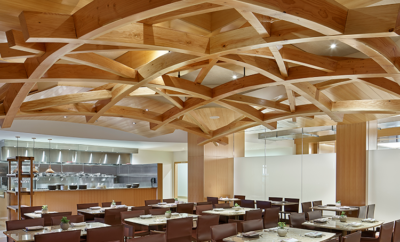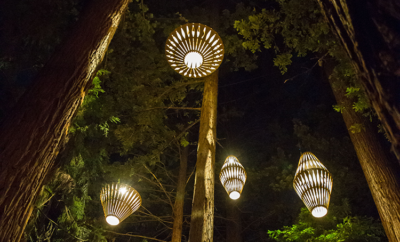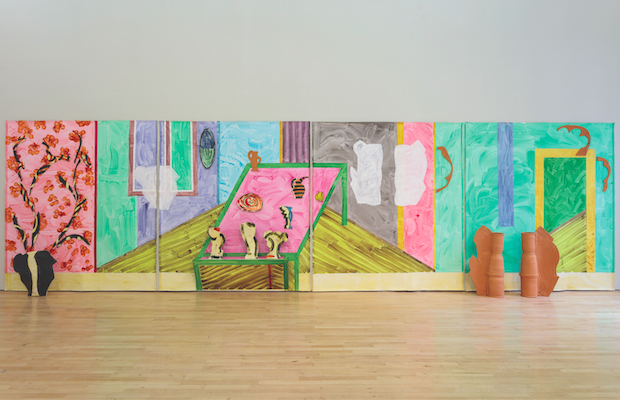 "The Summer House" by Betty Woodman, 2015. Mark Blower Photo
"The Summer House" by Betty Woodman, 2015. Mark Blower Photo
Feature
The Imaginative World of Betty Woodman
THE WORK OF BETTY WOODMAN is at once classical and convention-defying. A bold-faced name in the overlapping worlds of art and ceramics, Woodman boundlessly explores the domestic. The vessel is her subject, muse, and primary form. Over the course of a six-decade career, her use of clay has grown to incorporate a host of other materials and approaches, as she made a purposeful transformation from postwar production potter, making pots for the home, to celebrated artist, making pieces about pots for the home.
Meeting Woodman in her Chelsea loft and studio makes it clear that her work and life are intertwined. Everything in her world comes from the same impulse: the color on the walls, her carefully chosen coffee cup, her signature striped dress, paired with gridded socks and yellow sneakers. “Domestic activities are sort of clues for me,” she explains.

On the Way to Mexico by Betty Woodman, 2012. Glazed earthenware, epoxy resin, lacquer, and acrylic paint.
Home is not only the Manhattan loft but also a Tuscan farmhouse that she and her late husband, artist George Woodman, who died earlier this year, have owned for nearly half a century. Indeed, she first spoke to me by phone from her studio there in the olive-groved foothills of Antella, just beyond Florence. “It’s nice to belong after living here for fifty years,” she told me, pausing to whisper a greeting in Italian to a just-arrived guest. She explains that for a long time, “I wasn’t really accepted as an artist here—partly because I’m a woman, partly because I’m a foreigner, and partly because I work with ceramics.” But, as of late, that has changed.
As is evident from many a museum exhibition roster these days, we are in a moment of art historical rediscovery, with women artists and ceramics at the forefront. For Woodman, this has created a curious juxtaposition: she is simultaneously a major figure and a bit of a novel talent. In the United States, she has been a part of the larger conversation all along, intersecting with the Pattern and Decoration movement in the late 1970s, and then represented by the genre-bending Chelsea gallery of Max Protetch for more than two decades. In 2006 the Metropolitan Museum of Art organized a retrospective of her art, its first for both a living ceramist and for a living woman artist.
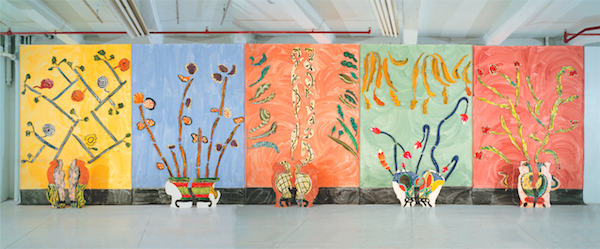
Ceramic Pictures of Korean Paintings, 2002. Glazed earthenware, clay, and canvas. From left to right the vessels are: Rose Lattice Tree Vase, Tiger Lily Tree Vase, Evergreen Tree Vase, Lotus Tree Vase, Camellia Tree Vase.
Although she has always had an international presence, for European audiences Woodman is still something of “a new figure in the contemporary context,” says Vincenzo de Bellis, curator of Betty Woodman: Theatre of the Domestic, the first solo museum exhibition of the artist’s work in Italy and the U. K. Taking a different format in each of its two locales, the highly praised show highlighted Woodman’s innovations over the last ten years. While her work has often resisted definition, de Bellis likens her method to collage in three dimensions. He sees “Betty’s work as a reflection of painting in whatever she does, whether it is ceramic or flat work on canvas—everything is color and composition.”
Woodman forthrightly says her inspiration “comes more directly from other works of art.” As a result, her pieces leap across art history, pulling from everywhere: Matisse, Tang Dynasty decoration, Renaissance painting, Islamic art. Woodman synthesizes all of them in her work, which is instantly recognizable as hers alone.
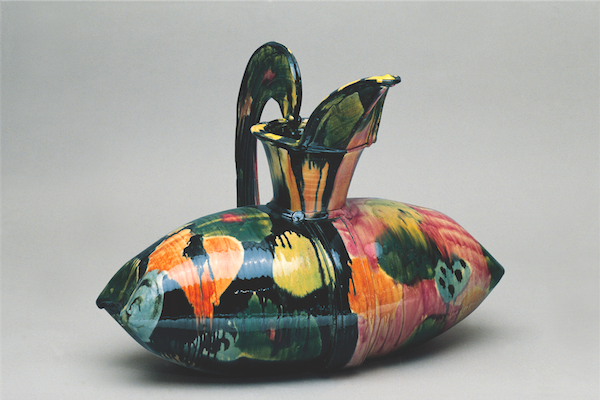
Rose et Noir Pillow Pitcher, 1989. Glazed earthenware, epoxy resin, lacquer, and paint.
Theatre of the Domestic originated in 2015 at the Museo Marino Marini in Florence. There, Woodman’s work was shown in the former church alongside that of the museum’s namesake sculptor, Marino Marini—two modern approaches that embrace the classical. Fittingly, the museum is not far from Antella, making Woodman’s Italian debut a long-awaited homecoming. At the Institute of Contemporary Arts in London, the show featured The Summer House, a twenty-eight-foot-long still life of changing perspectives. In the piece, vessels become flat, winged, patterned, and plain—or cloudy incantations on canvas. The Mediterranean sun abounds, making the work feel as effortless as it is complex. Notably, The Summer House also illustrates Woodman’s library of influences—the distinctive wash of yellow hints at the palette of Fra Angelico, the table nods to the paintings of Pierre Bonnard.
As she describes it, her “long love affair with Italy” began just after World War II when, Woodman says, there was “a sense that maybe you could do anything.” After studying ceramics at the School for American Craftsmen in western New York, she made her way to Florence. She found a job by knocking on the door of a pottery studio started by painter Giorgio Ferrero, with sculptor Leonello Fallacara making the forms. Woodman joined the studio for nearly a year, working with the material she still favors: humble glazed earthenware, which she has compared to fabric for its fluidity and immediacy. Of the artists at the workshop she says, “They didn’t know anything about the rules and I knew all the rules. And then I realized, maybe the rules were just there to be broken.”

Wallpaper #9, 2015. Glazed earthenware, epoxy resin, lacquer, and acrylic paint. Jeff Elstone Photo
Woodman has not only broken the rules, she’s rewritten them. “There’s no point in making work where I know what the solution is,” she says. “I have to be reaching for something that I’m not sure about.” The Pillow Pitcher form is an early example, a voluptuous pouring vessel that stands just outside of function. “If one goes to the Islamic section of the Met, there are all these beautiful pitchers,” she says. “In a way, the Pillow Pitcher became a vehicle for capturing the essence of those pitchers. I started to make a reference to their handles and spouts. My Pillow Pitchers also became a very nice surface, big enough for me to paint on and play with.”
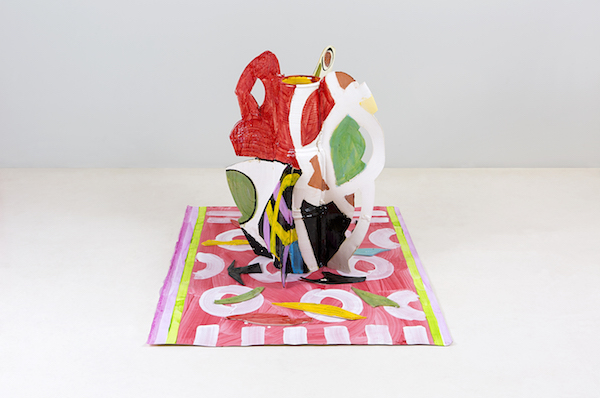
Aztec Vase and Carpet #8, 2015. Glazed earthenware, epoxy resin, lacquer, paint, and canvas. Jeff Elstone Photo
Today, this act of making continues to lead Woodman’s way. “It’s during the process that my ideas are formed,” she explains. For example, she began to paint on canvas with the 2002 installation Ceramic Pictures of Korean Paintings. The piece originally required clay-painted walls, but canvas became her solution after a New Year’s Eve spent washing the clay off a photographer’s studio walls. In turn, an architectural commission set just below a skylight at the American Embassy in Beijing led Woodman to use acrylic paint on the canvas instead of clay, since the latter could wash away with a ceiling leak. “That, of course, opened up an enormous possibility of color,” she says. “I think this has something to do with my training as a craftsperson. The practical issues become part of the process.”
Woodman’s recent Wallpaper series began as glazed ceramic castoffs meant as wall-hung parting gifts for visitors to her exhibition at Salon 94, the New York gallery that now represents her work. But when she saw the pieces together, she fell in love with the installation. Although she made good on her promise to send what she has called “spare parts” home with her audience, the format has since become a new body of work.
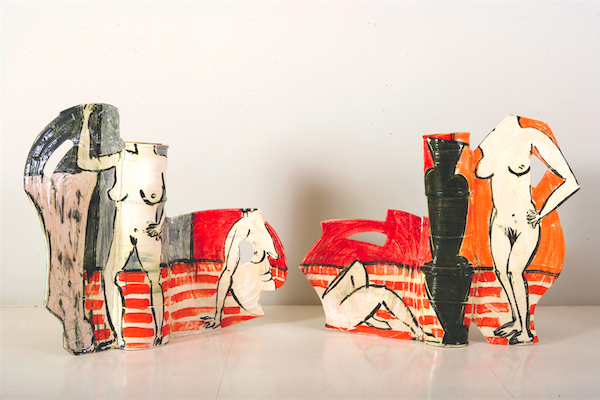
Roman Girls, 2008. Glazed earthenware, epoxy resin, lacquer, and paint. Ping Photo
Today, Woodman’s restless energy crackles against her insights, well-earned at the age of eighty-seven. For some, this moment would be a time to slow down, to look back, to take stock. Instead, Woodman is looking forward. As we stand in her New York studio, she maps out her newest series, Courtyards, already creating another insight into her ever-creative world.


